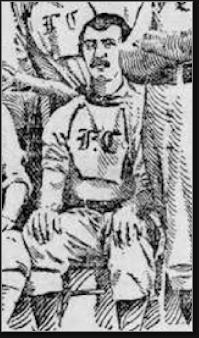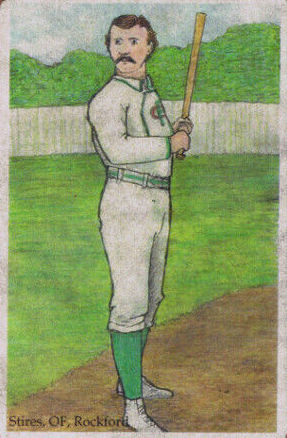
Sport: Baseball
Born: October 13, 1845
Died: June 13, 1931
Town: Pattenburg, New Jersey
arret C. Stires was born October 13, 1845 in Hunterdon County, NJ, near the farming community of Pattenburg. Around the age of nine, “Gat” accompanied his family west and grew up in Byron, Illinois. Farmwork helped him develop an impressive physique; he stood 5’8” and weighed over 180 pounds with nary an ounce of fat on his body.
The new sport of “base-ball” arrived in northern Illinois when Gat was in his early 20s and he excelled as both a hitter and fielder. There was nothing scientific about the way he played—the big left-hander wielded the bat like a war club and hit the ball a mile. He also had a powerful (but not always accurate) throwing arm.
Gat was invited to join the Rockford Forest Citys in 1868. He was quite a sight when he arrived, sporting flowing hair and frontier buckskins. The Forest Citys were one of the top amateur clubs in the Midwest at the time, in part because they almost certainly compensated their best players. In a game against the touring Brooklyn Atlantics, Gat hit a ball with the bases loaded that was last seen soaring over the carriages that ringed the outfield for a grand slam.
In 1869, Gat missed the entire season due to illness, but returned in 1870. In an October meeting with the heralded Cincinnati Red Stockings, he hit a home run over centerfielder Harry Wright’s head that required Wright to wade through a stream and climb a hill to retrieve. Slugging averages were not a statistic yet, but existing records suggest Gat was the most destructive hitter in American baseball that year.

In 1871, the Forest Citys joined the first professional league, the National Association. Gat led the club in extra-base hits and RBIs. The Rockford lineup included a young star named Cap Anson that year. The team disbanded in 1872 and Gat decided it was time to return to farm work. He had a couple of forays out west as a surveyor and prospector but lived out his life back home in Byron, where he carved out a folklorish reputation and grew prosperous as a stock rancher in the 1880s and 1890s.
Gat was still alive when Babe Ruth borrowed his batting approach to transform baseball in the 1920s. He passed away in 1931.